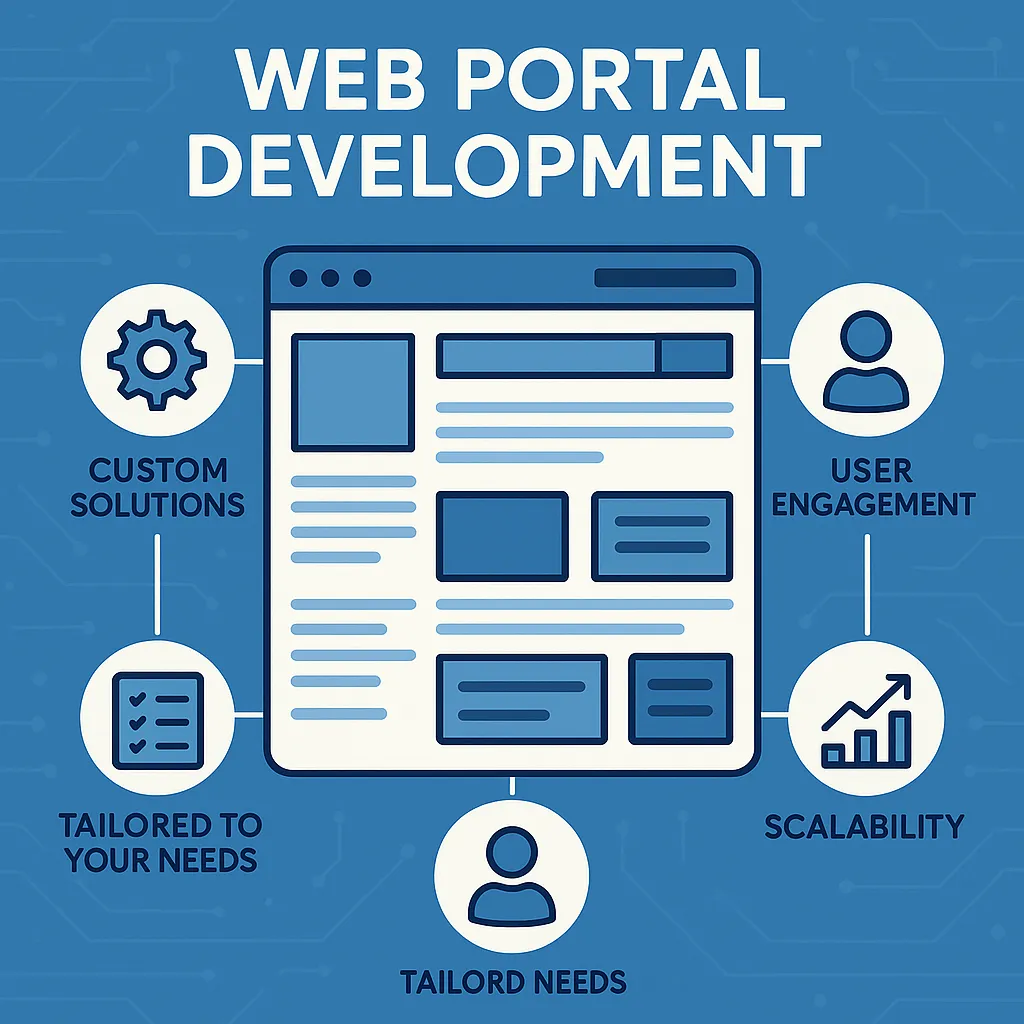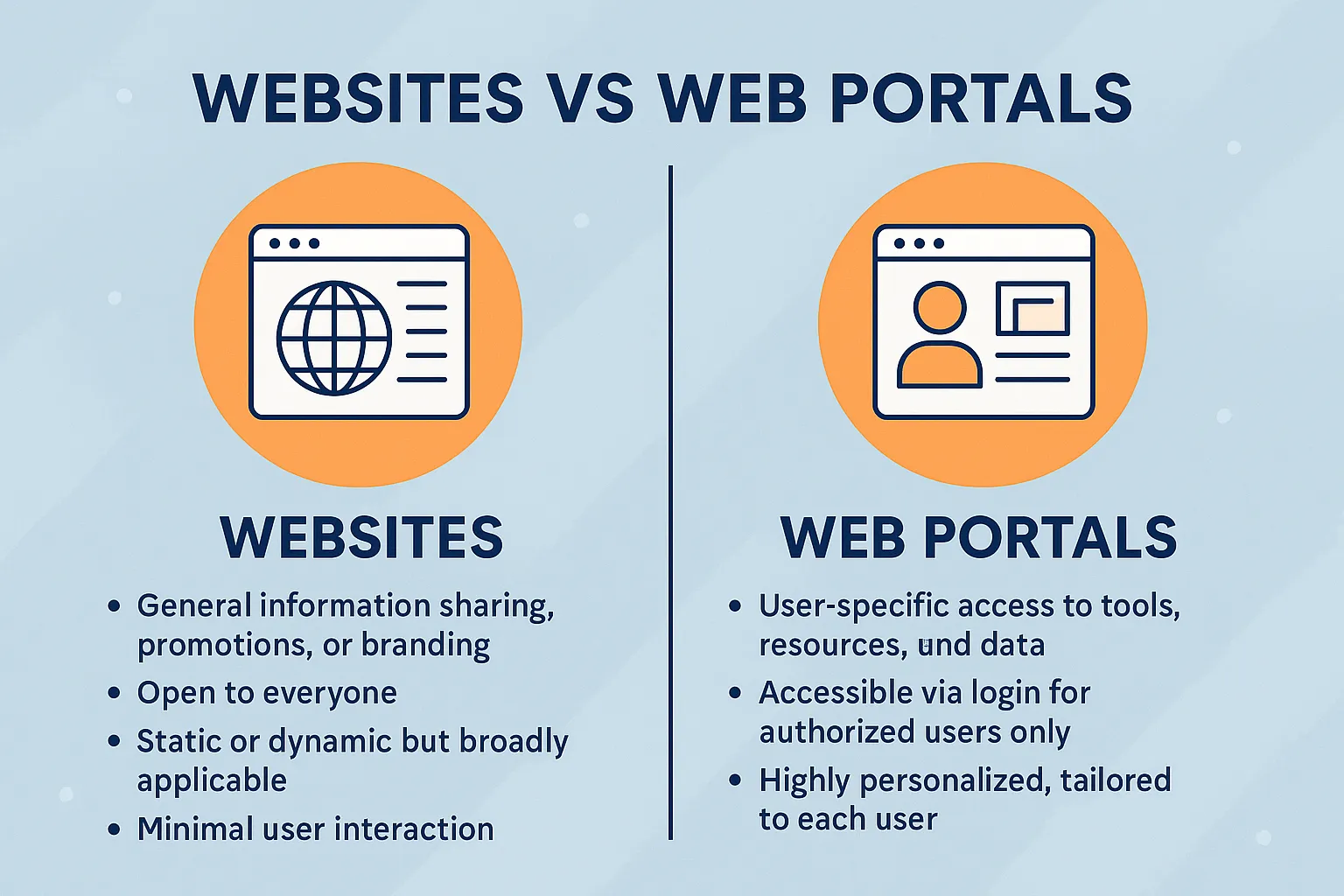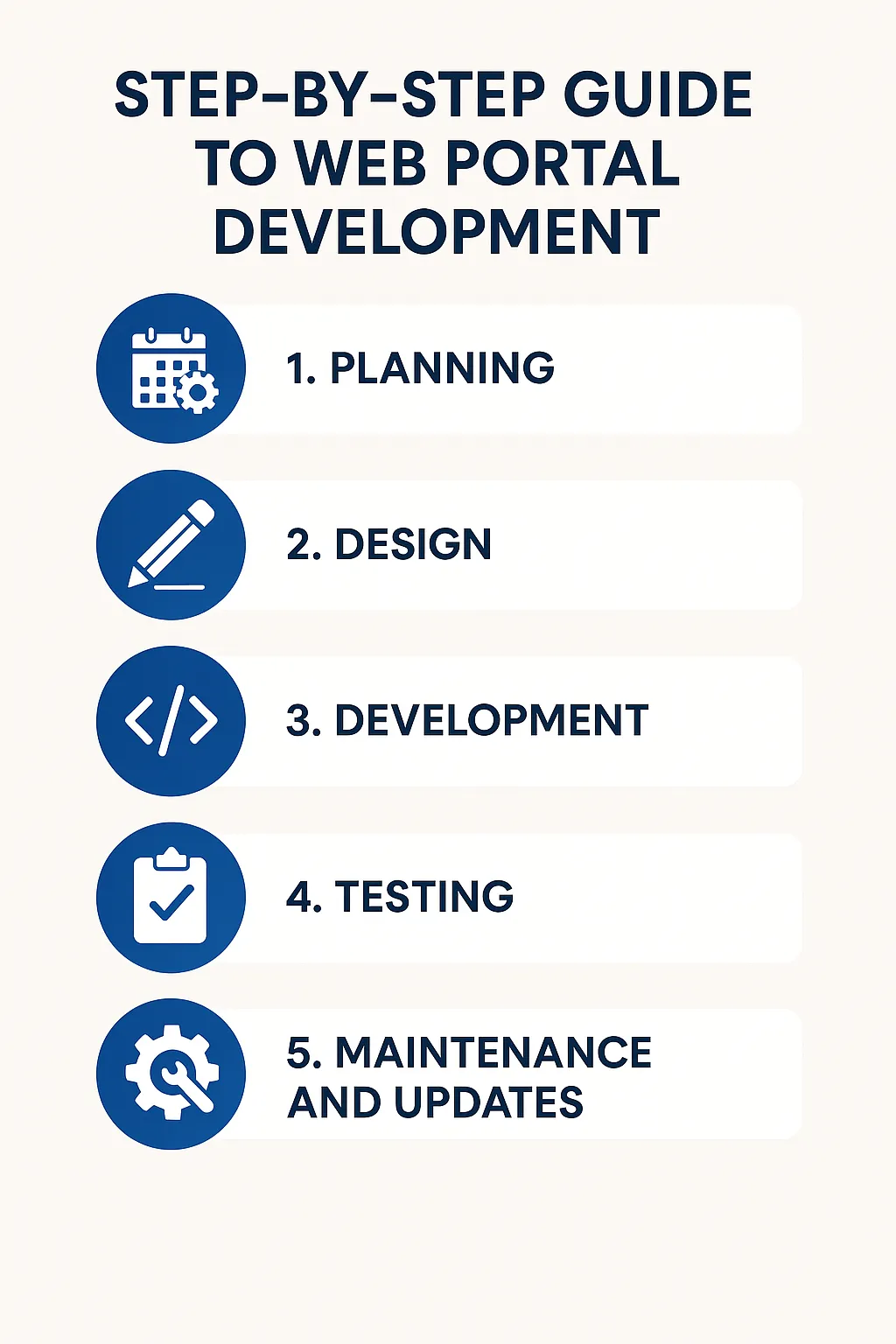Web portal development is a transformative solution for businesses looking to streamline operations, enhance customer engagement, and offer a tailored digital experience. Whether you're building customer-oriented platforms or internal employee hubs, web portals cater to specific user needs and help organisations improve overall efficiency.

If your business is considering a custom web portal, understanding its importance and development process is critical.
This blog will walk you through the essentials of web portal development, its benefits, and how you can take the first step with help from a reliable service provider like newweborder.co.
What is Web Portal Development and Why Does It Matter?
Web portal development is the process of creating an advanced digital platform that consolidates various services, data, and tools in one centralised location, accessible to a defined user audience.
Unlike websites, which are often designed for broad visibility, web portals focus on personalised experiences, offering tailored content and functionality to users based on specific roles or needs, such as customers, employees, or vendors.
Why should businesses care?
Web portals can improve user engagement by providing context-appropriate information and tools, enhance communication between stakeholders, and help organisations manage resources efficiently.
From e-learning platforms to e-commerce hubs, custom web portal solutions are versatile and scalable, making them indispensable in today’s digital-first economy.
Websites vs Web Portals – What Sets Them Apart?

At first glance, websites and web portals may seem similar, but their purpose, functionality, and audience differ significantly. Here’s a breakdown of the key differences:
Purpose:
● Website: General information sharing, promotions, or branding.
● Web Portal: User-specific access to tools, resources, and data.
Accessibility:
● Website: Open to everyone.
● Web Portal: Accessible via login for authorized users only.
Content:
● Website: Static or dynamic but broadly applicable.
● Web Portal: Highly personalized, tailored to each user.
Interaction Level:
● Website: Minimal user interaction.
● Web Portal: Extensive interaction including data submission, requests, etc.
Examples:
● Website: Marketing websites, blogs.
● Web Portal: Customer portals, employee dashboards, e-learning platforms.
While websites are ideal for organisations aiming to reach a wide audience and increase their online presence, web portals are perfect for businesses focused on delivering customised functionality, facilitating seamless interaction, and improving user engagement.
By serving distinct purposes, websites and portals create opportunities for businesses to cater to both a general audience and specific user groups.
Opting for the right platform depends on your audience’s needs and your business objectives.
Whether you’re looking to inform and attract customers or enhance interactivity through tailored tools, understanding these differences can help drive better outcomes.
Step-by-Step Guide to Web Portal Development

Building a custom web portal requires a structured approach to ensure functionality, usability, and scalability. Here’s a detailed roadmap for creating a successful business web portal:
1. Planning
The foundation of a successful web portal lies in research and planning. During this stage, you will:
● Identify Goals & Target Audience: Define the purpose of your portal, whether it’s for enhancing customer experience, boosting employee productivity, or managing vendor relations.
● Analyse Requirements: Collect feedback from potential users to understand their pain points and expectations.
● Budget & Timeline: Outline costs and timelines to prevent delays or resource shortages later.
Newweborder.co provides expert consulting services to help businesses efficiently plan their web portal projects.
2. Design
The design phase transforms abstract ideas into interactive wireframes and prototypes. Key components include:
● Responsive UI/UX Design: Ensure the portal delivers a seamless experience across devices.
● Custom Functionality: Incorporate user-specific features like dashboards, search capabilities, and role-based access.
● Aesthetics Combined With Usability: Align branding with usability to engage users effectively.
3. Development
Development focuses on building the functional core of your web portal:
● Front-End Development involves creating the user-facing side with technologies like HTML, CSS, JavaScript, or frameworks such as React.
● Back-End Development powers the portal's functionality using robust platforms like Python, .NET, or Node.js.
● Database Integration ensures secure and scalable data storage, enabling features like user authentication and personalised sessions.
4. Testing
Testing ensures the portal meets performance, usability, and security standards.
● Functional Testing: Check that all features work as intended.
● Performance Testing: Analyse load times and responsiveness during peak traffic.
● Security Checks: Safeguard against vulnerabilities using encryption and two-factor authentication.
● User Feedback: Conduct trials with a small group to solve potential usability concerns.
5. Maintenance and Updates
Post-launch maintenance is crucial to ensure the portal remains functional and relevant:
● Content Updates: Regularly refresh information to keep users engaged.
● Feature Enhancements: Add new tools or capabilities based on user feedback.
● Bug Fixes and Security Upgrades: Monitor the portal continuously for vulnerabilities or glitches and resolve issues promptly.
For ongoing maintenance and agile updates, consider partnering with newweborder.co for reliable support.
Learn more about : How to Make a Social Networking App
The Benefits of Web Portal Development
Investing in a tailored web portal yields multiple benefits for businesses across industries. Here’s how you stand to gain:
1. Improved User Engagement
By offering personalised services and easy navigation, web portals enhance user interactions.
Whether it’s customers using an e-commerce portal or employees accessing an intranet, customisation ensures a seamless, productive experience.
2. Streamlined Operations
Portals bring all essential services and tools under one roof, eliminating inefficiencies caused by siloed systems.
For example, a centralised employee portal can integrate payroll, HR tools, and task management, reducing administrative overhead.
3. Boosted Customer Satisfaction
Customer portals empower users with self-service options like tracking orders, accessing support, and managing accounts.
This convenience translates to higher customer satisfaction and loyalty.
4. Scalability and Adaptability
Modern web portals are built to adapt. Whether your business grows in size or diversifies its operations, portals can easily scale to meet new demands by adding functionalities.
5. Data Insights and Analytics
With integrated dashboards and reporting tools, portals enable businesses to track user behaviour, identify trends, and make data-driven decisions.
6. Enhanced Security
With role-based access and encrypted data exchanges, web portals enhance security, ensuring sensitive information remains protected.
Emerging Trends in Web Portal Development
Staying ahead of technological advancements ensures your portal remains competitive and user-friendly. Here are some key trends reshaping the space in 2025:
1. Progressive Web Applications (PWAs)
PWAs enable web portals to work offline, offer push notifications, and deliver app-like user experiences. Companies like Uber have seen tremendous success with PWA technologies.
2. Artificial Intelligence (AI) and Chatbots
AI-powered tools like automated chatbots significantly enhance user interaction, resolve queries faster, and improve customer retention.
3. Cloud Computing
Cloud-hosted portals empower businesses with scalability, flexibility, and cost savings by centralizing operations without the need for extensive on-premise infrastructure.
4. Cybersecurity Enhancements
With increasing online threats, security trends like increased encryption protocols, two-factor authentication, and real-time threat monitoring have become non-negotiables for modern portals.
5. Content Personalization
Machine learning algorithms now help portals provide dynamic content tailored to user preferences and browsing behavior, further enhancing engagement.
Challenges and Best Practices
Challenges
● High Initial Investment: Developing a fully custom web portal can be resource-intensive.
● Data Security Risks: The accumulation of sensitive data makes portals a target for cyberattacks.
● Scalability Issues: Not planning for growth can limit portal functionality as your business scales.
Best Practices
● Adopt Agile Development: Enables quick adjustments to user feedback.
● Prioritize User-Centric Design: Ensure accessibility and ease of use for all users.
● Focus on Security: Proactively mitigate risks with robust protocols like SSL and role-based access control.
Real-World Examples
Customer Portal – Starbucks Rewards
The Starbucks Rewards program provides a personalized dashboard for users to track points, make transactions, and receive special offers through an integrated web and mobile portal.
Employee Portal – Microsoft SharePoint
SharePoint facilitates seamless collaboration within organizations through document sharing, task assignments, and workflows, ensuring organizational efficiency.
Vendor Portal – FedEx Insight
FedEx Insight offers real-time tracking updates and predictive alerts, enabling vendors to manage supply chains more effectively.
Why Choose Newweborder.co for Your Web Portal Development?
When building a sophisticated web portal, partnering with an experienced service provider can make all the difference.
At newweborder.co, we specialise in creating custom web portal solutions tailored to meet your unique business needs.
Our expertise spans various technology stacks, ensuring scalability, security, and user-centric designs.
Whether you’re just starting with a concept or need to modernise an outdated system, our team is ready to assist you at every stage of development.
Stay Ahead with Innovative Web Portals
Web portal development is more than just a trend—it’s a necessity for businesses aiming to enhance their digital footprint and streamline operations. From improving customer engagement to making data-driven decisions, the benefits are undeniable.
If you’re ready to propel your business forward with a powerful web portal, start your project with New Web Order Contact Us now.
Frequently Asked Questions About Web Portal Development
1. What Is Web Portal Development?
Web portal development involves building a centralised online platform that provides users access to personalised information, services, and communication tools.
Unlike standard websites, portals are designed to aggregate content and functionality from multiple sources, offering a comprehensive and user-specific experience.
For instance, a company intranet is a type of portal where employees can log in to access business resources, company news, or HR tools.
Similarly, a client portal may allow customers to track orders, request support, and view account information.
The development process typically includes designing the user interface (UI), creating backend systems, integrating APIs, and testing for scalability and performance.
2. Why Is Web Portal Development Important for Businesses?
Web portal development offers several benefits to businesses, including improving process efficiency, delivering better customer experiences, and fostering collaboration.
Key reasons why it matters:
● Centralised Access: A web portal brings together tools, services, and information in one place, saving time and reducing complexity.
● Improved Customer Engagement: Client portals empower customers by giving them around-the-clock access to information and support.
● Enhanced Productivity: Employee portals improve internal workflows by streamlining communication and resource sharing.
By building a custom web portal tailored to their needs, businesses can gain a competitive edge.
3. What Are the Key Features of a Web Portal?
The success of a web portal lies in its functionality and usability. Common features include:
● Single Sign-On (SSO): Allows users to log in once and access multiple systems or tools.
● Personalised Dashboard: Displays user-specific data and preferences for a more tailored experience.
● Search Functionality: Helps users quickly find information within the portal.
● Role-based Access Control: Ensures different users only access data appropriate to their role.
● Integration with Other Systems: Links with CRMs, ERPs, or other third-party applications for seamless workflows.
● Responsive Design: Ensures the portal works on all devices, including desktops, tablets, and smartphones.
● Security Features: Includes SSL encryption, secure authentication protocols, and data privacy measures.
4. How Much Does Web Portal Development Cost?
The cost of web portal development varies depending on several factors, including the complexity of the project, the number of features, and the technologies used.
On average, costs can range from £10,000 for a small portal to over £100,000 for a complex, enterprise-level solution.
Key cost factors include:
● Scope of work (number of features, level of customisation)
● Development team expertise
● Integration with third-party tools
● Ongoing maintenance and support
It’s often a good idea to work with a professional web development company to get a precise estimate tailored to your business requirements.
5. What Are the Different Types of Web Portals?
Web portals come in various forms, depending on their intended users and functions. Common types include:
● Employee Portals: Designed for internal use, these portals streamline communication, resource sharing, and collaboration among employees.
● Customer Portals: Allow customers to access support tools, account details, and self-service options.
● E-commerce Portals: Facilitate online shopping and integrate with payment systems, inventory management, and more.
● Educational Portals: Used by schools and universities to provide students and staff with learning resources.
● Healthcare Portals: Offer patients access to medical records, appointment scheduling, and healthcare services.
6. How Long Does It Take to Develop a Web Portal?
The development time depends on the scope and complexity of the portal. On average, it can take anywhere from 3 to 12 months to develop a custom web portal.
Timeline breakdown:
● Planning and Design: 4–6 weeks
● Development and Coding: 2–6 months (depending on features)
● Testing and Deployment: 1–2 months
Agile development practices can help speed up the process by breaking it into smaller, more manageable phases.
7. What Technologies Are Used in Web Portal Development?
Developing a web portal typically involves a combination of frontend, backend, and database technologies. Common tools and frameworks include:
● Frontend: HTML5, CSS3, JavaScript frameworks (React.js, Angular.js, Vue.js)
● Backend: Node.js, Python, Ruby on Rails, or PHP
● Database: MySQL, MongoDB, PostgreSQL
● Hosting Platforms: AWS, Microsoft Azure, or Google Cloud Platform
● APIs: For third-party integrations
The specific technologies depend on your portal’s requirements, user base, and scalability needs.
8. Can a Web Portal Be Customized for My Business Needs?
Yes, web portals can be fully customised to align with your business goals, workflows, and branding.
Customisation options include tailoring the user interface, integrating specific tools or software, and incorporating unique features tailored to your audience.
Working with a professional development team ensures that all customisation and functionality align with your business objectives.
9. What Is the Difference Between a Website and a Web Portal?
While both websites and web portals exist online, they differ in purpose and functionality.
● Website: Offers general information to all visitors. It’s more static and does not require personalisation.
● Web Portal: Provides a personalised experience, allowing users to log in and access unique features or data.
Web portals are more interactive and user-focused, whereas websites are geared towards broader public consumption.
10. How Do I Choose the Right Web Portal Development Company?
Choosing the right development partner is crucial for delivering a high-quality portal. Consider the following factors when making your decision:
● Experience: Look for companies with proven expertise in building web portals.
● Portfolio: Review their past projects to evaluate the quality of their work.
● Customisation Capabilities: Ensure the company can tailor solutions to your specific needs.
Take the next step today, and make your portal the key to operational excellence and improved user satisfaction.


